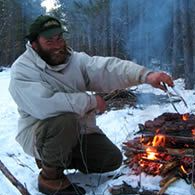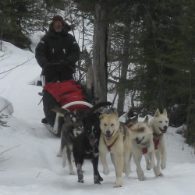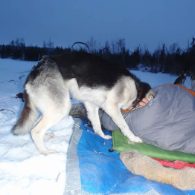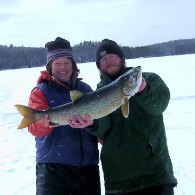List of What to Bring On A White Wilderness Adventures Authentic Dog Sledding Trip
- Two sets of long underwear. A synthetic like Thermax, polypropylene, or Capilene will work well. One pair, midweight recommended.
- Three sets of heavy synthetic or wool socks. These should be wool or synthetic. Liner socks are also nice (think of them as long underwear for your feet). In addition, if you tend to have sweaty feet, a vapor barrier sock (a sock made of waterproof material) will help keep your boots dry and your feet warm, especially on multi-day trips.
- Two winter hats. One hat should be thinner for warmer weather or higher activity levels. It is best for your other hat to be thicker and to have a wind block layer, like a nylon shell. A hat with a brim is also helpful.
- Gloves and mittens. It is important to have both gloves and mittens. If you just have gloves your hands will probably get cold. A couple of pairs of thin to mid-weight gloves like synthetic liner gloves, or fleece gloves will be nice for the times you need dexterity. A heavy warm pair of mittens are essential. The mittens should fit comfortably over the gloves. Mitten shells or over mitts (nylon or leather) are helpful. For camping trips, leather choppers are good for handling hot items around the fire.
- Fleece pants, wool pants or expedition weight bottoms. You know yourself better than we do. A warm-blooded person will only wear one pair, while a cold-blooded person may wear two or more pairs of pants. Use your judgment on how many you should bring.
- Two heavy-weight tops. This includes fleece shirts, wool sweaters or expedition weight layers. You should be able to wear both tops at the same time. Having layers of two different thicknesses is a good idea. A vest (synthetic or down) adds a great optional third layer without constricting the arms.
- A hooded winter jacket or parka. This can be a down parka or a fleece jacket. It is important that it has some loft to it and that it has a hood. If using a fleece jacket, it should fit under your wind shell without constriction.
- A hooded wind shell jacket. This is what you will be wearing non-stop during the day while you are active. You will want it to fit over all of your other clothing. Note that with a parka this wind shell is likely integrated into the jacket. Basically, whether you wear a layering system or a parka, your outside layer must be windproof and hooded.
- Wind pants (snow, ski pants). These serve the same function as the wind shell jacket. You do not want to wear fleece or wool pants as your outer layer because they will collect snow. Nylon pants will allow the snow to be brushed off. These pants can be insulated or un-insulated.
- Boots. Cold feet will ruin a trip, so having the right boots is extremely important. Winter boots need to have removable liners and insoles that can be pulled out to dry at night. (Alternatively, military Beta Boots, black or white, work great.) Bring an extra pair of liners if participating in a camping trip. Be aware that tight footwear means cold feet. Many people who experience cold feet wear too many socks or have boots that are too tight. Tight boots cut off the circulation, which leads to cold feet. Examples of good boots include Sorrels, LaCrosse Icemans, mukluks, etc. Winter boots with removable liners are sometimes referred to as “pack boots”. Beware of winter boots that say they are good to -20F but do not have removable liners. They will not keep your feet warm even in the most moderate of trips.
- Sunglasses. Most people are familiar with the sun reflecting off the water. Sun reflecting off the snow is equally bright or brighter than the sun off the water. That combined with sun low in the sky in the north creates a need for eye protection.
- Water Bottle. Again, it is very important to stay hydrated. One-quart wide-mouth Nalgene bottles work great. Smallmouth bottle tops typically freeze quickly. You may wish to toss the bottle into a spare wool sock or two to prevent unwanted freezes.
Fleece refers to synthetic fleeces such as PolarTec or Turtle Fur.
Packing List
- 1-2 pairs long underwear (tops and bottoms)
- 3 pairs heavy socks (not cotton)
- 1-2 pairs liner socks (optional)
- 2 warm winter hats
- 1-2 pairs liner gloves (should fit inside mittens)
- 1-2 pairs mittens
- 1 neck gaitor, scarf, ski mask or balaclava
- 1-2 pairs fleece or wool pants
- 2 warm synthetic fleece shirts or wool sweaters
- 1 parka or wind shell with extra insulating layers
- 1 pair wind pants
Additional Items
- Sunglasses
- Sunscreen / Lip protection SPF 30 or greater
- Toiletries (Toothbrush, toothpaste, medications)
- Water bottle (quart size; wide mouth won’t freeze as fast)
- Hand warmers / Foot warmers
- Camera with extra batteries
- Headlamp or Flashlight with spare batteries
- Swimsuit (for possible sauna/hot tub/pool)
- Towel
- Lightweight shoes or slippers (for yurt or lodge)
- Down or synthetic booties (for camping trips)
- Duffle bag, suitcase or backpack to put it all in
- Dog cookies (i.e. Milkbones)
- Summer weight sleeping bag, optional for yurt trips, recommended for camping trips (compact 20F-30F bag to use as a liner bag inside our winter sleeping bags)







